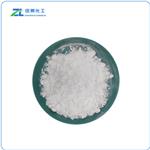- Oxaliplatin
-

- $200.00 / 1kg
-
2024-04-24
- CAS:61825-94-3
- Min. Order: 1kg
- Purity: 99%
- Supply Ability: 20ton
- Oxaliplatin
-

- $0.00 / 25KG
-
2024-04-22
- CAS:61825-94-3
- Min. Order: 2KG
- Purity: EP7.2
- Supply Ability: 20tons
- Oxaliplatin
-

- $0.00 / 1KG
-
2024-03-16
- CAS:61825-94-3
- Min. Order: 100g
- Purity: 98%+
- Supply Ability: 100kg
|
| | Oxaliplatin Basic information |
| Product Name: | Oxaliplatin | | Synonyms: | [SP-4-2-(1R-TRANS)]-(1,2-CYCLOHEXANEDIAMINE-N,N')[ETHANEDIOATA(2-)-O,O']PLATINUM;OXALIPLATIN;trans-l-diaminocyclohexane oxalatoplatinum;(1,2-cyclohexanediamine-n,n’)(ethanedioato(2-)-o,o’)-platinu(sp-4-2-(1r-tr;oxalato(1r,2r-cyclohexanediammine)platinum(ii);oxalatoplatin;[SP-4-2-(1R-trans)]-(1,2-Cyclohexanediamine-N,N,)[ethanedioato(2-)-O,O’Jplatinum;NSC-266046:Elocatin | | CAS: | 61825-94-3 | | MF: | C8H12N2O4Pt | | MW: | 395.28 | | EINECS: | 621-248-1 | | Product Categories: | Intermediates & Fine Chemicals;Pharmaceuticals;Pharmaceutical material and intermeidates;Active Pharmaceutical Ingredients;Antineoplastic;Inhibitors;PRAXILENE;chemical reaction,pharm,electronic,materials;Amines;Heterocycles;APIs;API;61825-94-3 | | Mol File: | 61825-94-3.mol |  |
| | Oxaliplatin Chemical Properties |
| alpha | +74.5-78.0 (D/20)(c=0.5,H2O) | | storage temp. | 2-8°C | | solubility | Slightly soluble in water, very slightly soluble in methanol, practically insoluble in anhydrous ethanol. | | form | solid | | color | White to Almost white | | Water Solubility | Soluble in water with heating and/or sonication | | Merck | 14,6912 | | Stability: | Stable. Store cool. Incompatible with oxidizing agents. | | InChI | InChI=1/C6H12N2.C2H2O4.Pt/c7-5-3-1-2-4-6(5)8;3-1(4)2(5)6;/h5-8H,1-4H2;(H,3,4)(H,5,6);/q-2;;+4/p-2/t5-,6-;;/s3 | | InChIKey | ZROHGHOFXNOHSO-BNTLRKBRSA-L | | SMILES | O=C1C([O-][Pt+2]2(N[C@]3([H])CCCC[C@@]3([H])N2)[O-]1)=O |&1:6,12,r| | | CAS DataBase Reference | 61825-94-3 |
| Hazard Codes | Xn,Xi | | Risk Statements | 36/37/38-40-42/43 | | Safety Statements | 26-36 | | RIDADR | 2811 | | WGK Germany | 3 | | RTECS | TP2275850 | | HazardClass | 6.1(a) | | PackingGroup | II | | HS Code | 28439000 | | Toxicity | LD50 intraperitoneal in mouse: 19800ug/kg |
| | Oxaliplatin Usage And Synthesis |
| Description | Oxaliplatin is a second generation platinum drug prepared in three steps from either k2tCl4 or K2Ptl4. It has an antitumor spectrum similar to cisplatin, however, it is more effective against L1210 leukemia and cisplatin resistant L1210. It is also effective against B16 melanoma but has a dose limiting toxicity of peripheral sensory neuropathy that is reversible upon cessation of the drug. The (R,R)- enantiomer has greater activity than the (S,S)-isomer but this is tumor line dependent, e.g., there was no difference found for P-388 or Sarcoma 180. Clinical drug administration based on circadium timing showed it was better tolerated when given 16 h after the onset of light. Oxaliplatin binds to guanineN7 and can lead to bidentate chelation that results in the bending of DNA. This feature is recognized by high mobility group proteins (HMG) which impedes repair reactions and stops replication and transcription. | | Chemical Properties | White Crystalline Solid | | Originator | Bebiopharm (Switzerland) | | Uses | A potent anti-neoplastic agent that binds to DNA and shows efficacy in Cisplatin resistant cell lines | | Uses | Third generation platinum complex. An antitumor agent with activity against colorectal cancer. Cytotoxicity follows the formation of adducts with DNA. Antineoplastic. | | Uses | Oxaliplatin is a platinum-based antineoplastic agent that functions by forming DNA adducts specifically in cancer cells, preventing DNA replication and transcription which leads to cell death. Oxaliplatin has cytotoxic effects in a broad range of cell lines, including colon, ovarian, and lung cancer, with IC50 values ranging from 0.5-240, 0.12-19.8, and 2.6-6.1 μM, respectively. Through its general cytotoxic effects, oxaliplatin has anti-tumor activity against advanced colorectal cancer and is typically administered with fluorouracil and leucovorin in a combination known as FOLFOX. | | Indications | Oxaliplatin, also called Eloxatin or Eloxatine, is a platinum derivative. Used clinically to treat patients with metastatic colorectal cancer after failure of fluorouracil treatment, can be used alone or in combination with 5-fluorouracil. It is the third-generation platinum antitumor compound after cisplatin and carboplatin, and so far the only platinum-based drug with significant effectiveness against colorectal cancer. It also inhibits proliferation of ovarian cancer and melanoma cell lines. | | Brand name | Eloxatin (Sanofi Aventis). | | General Description | Oxaliplatin is available in 50- and 100-mg vials for IV administrationin the treatment of ovarian cancer, metastaticcolorectal cancer, and early stage colon cancer in combinationwith 5-fluorouracil/leucovorin. The activation of theagent occurs in low-chloride environments to give theaquated species, which subsequently reacts with DNA in amanner similar to cisplatin. The mechanisms of resistance aresimilar for the two agents; however, oxaliplatin is not recognizedby MMR enzymes and does not show cross-resistancewith cisplatin. The agent is widely distributed, highly proteinbound (85%–88%), and irreversibly binds to erythrocytes.Numerous metabolites have been identified many of whichare produced as a result of nonenzymatic processes and includechloro-, dichloro-, monoaquo-, and diaquo-species.The parent and metabolites are eliminated primarily in theurine with a long terminal elimination half-life of 240 hours.Neurotoxicity is dose limiting and normally presents as peripheralneuropathy, which may be exacerbated by exposureto low temperatures. The neurotoxicity is normally reversiblein contrast to that seen with cisplatin, which may be irreversible.Other adverse effects include nausea, vomiting, diarrhea,myelosuppression, and hypersensitivity reactions.Ototoxicity and renal toxicity occur only rarely in contrast tocisplatin. | | Biological Activity | Oxaliplatin is a platinum-containing DNA-crosslinking agent. It induces the formation of DNA inter- and intrastrand crosslinks and DNA-protein crosslinks, inhibits DNA and RNA synthesis, and induces apoptosis in cancer cells. Oxaliplatin is cytotoxic to cisplatin-sensitive A2780(1A9) and KB-3-1 cells and cisplatin-resistant A2780-E(80) and KB-CP20 cells (IC50s = 0.12, 0.39, 4.7, and 2.7 μM, respectively). It reduces tumor growth in an HCCLM3 mouse xenograft model when administered at doses of 5 or 10 mg/kg once per week. Formulations containing oxaliplatin have been used in the treatment of advanced colorectal cancer and as an adjuvant in stage III colon cancer. | | Biochem/physiol Actions | Oxaliplatin a platinum analogue, causes DNA damage and cell death by binding to DNA and forming inter and intrastrand crosslinks preventing replication and transcription. Oxaliplatin is an anti-tumor agent with activity against colorectal cancer; cytotoxicity follows the formation of adducts with DNA. Oxaliplatin is an approved drug for treating colorectal cancer. It is an active ingredient in FOLFOX (Folinic acid:5-FU:oxaliplatin in the ratio 1:10:1 of micromolar concentrations respectively). Oxaliplatin causes both acute and chronic neurotoxicity in patients in a dose dependent manner and is reversible either by reducing or stopping the drug. | | Side effects | Hematopoietec system: Oxaliplatin has a certain blood toxicity. When used alone, it can cause the following adverse effects: anemia, leukopenia, neutropenia, thrombocytopenia, sometimes reaching grade 3 or 4. Increases hematologic toxicities such as neutropenia and thrombocytopenia when combined with 5-fluorouracil.
Digestive system: can cause nausea, vomiting, and diarrhea when used alone. These symptoms can sometimes be very serious. These side effects are significantly exacerbated when used in combination with 5-fluorouacil. Use of prophylactic and/or therapeutic antiemetic drugs is recommended.
Nervous system: Peripheral sensory neuropathy characterized by peripheral neuritis. Sometimes associated with convulsions and sensory disturbances in the mouth, upper respiratory tract, and upper GI tract. | | Safety Profile | A poison by intraperitoneal route. When heated to decomposition it emits toxic vapors of NOx and Pt. | | Synthesis | An aqueous solution of 5 g of (1R,2R)-(-)-1,2-DiaMinocyclohexane and 18 g of K2(PtCl4) was reacted for 12 h at room temperature to give 12 g of compound (I). 6: 8 g of silver nitrate was added to an aqueous solution of 3 g of compound (I) and stirred for 2-3 h away from light, then 4.8 g of dipotassium oxalate was added and the reaction was carried out for 8 h at room temperature to give oxaliplatin. | | in vitro | oxaliplatin is active against human melanoma cell lines c32 and g361 with the ic50 values of 0.98 mm and 0.14 mm, respectively. oxaliplatin effectively inhibited bladder carcinoma cell lines rt4 and tccsup, ovarian carcinoma cell line a2780, colon carcinoma cell line ht-29, glioblastoma cell lines u-87mg and u-373mg, and melanoma cell lines sk-mel-2 and ht-144 with the ic50 values of 11 μm, 15 μm, 0.17 μm, 0.97 μm, 17.6 μm, 2.95 μm, 30.9 μm and 7.85 μm, respectively. | | in vivo | a weekly injection of oxaliplatin (10 mg/kg, i.p.) to nude mice bearing hepatocellular hcclm3 tumors significantly reduces tumor volume and apoptotic index. oxaliplatin (5 mg/kg, i.v. on days 1, 5 and 9) was active on t-leukemia-lymphoma l40 akr with t/c of 1.77. oxaliplatin was also efficient on intracerebrally grafted l1210 leukemia, b16 melanoma xenografts, ma 16-c xenografts, lewis lung xenografts and c26 colon carcinoma xenografts. oxaliplatin induced impairment of retrograde neuronal transport in mice. | | storage | Store at +4°C | | Mode of action | Oxaliplatin, a platinum derivative, is an alkylating agent. Acts on DNA through production of alkylating conjugates, inhibiting its synthesis and reproduction by forming interchain and intrachain cross-links. Following intracellular hydrolysis, the platinum compound binds to DNA forming cross-links which inhibit DNA replication and transcription, resulting in cell death. | | references | [1]. culy cr, clemett d, wiseman lr. oxaliplatin.a review of its pharmacological properties and clinical efficacy in metastatic colorectal cancer and its potential in other malignancies.drugs. 2000 oct;60(4):895-924.
[2]. raymond e, faivre s, chaney s et al. cellular and molecular pharmacology of oxaliplatin. mol cancer ther. 2002 jan;1(3):227-35.
[3]. stein a, arnold d. oxaliplatin: a review of approved uses. expert opin pharmacother. 2012 jan;13(1):125-37.
[4]. hoff pm, saad ed, costa f et al. literature review and practical aspects on the management of oxaliplatin-associated toxicity. clin colorectal cancer. 2012 jun;11(2):93-100.
[5]. hall md, et al. say no to dmso: dimethylsulfoxide inactivates cisplatin, carboplatin, and other platinum complexes. cancer res. 2014 jul 15;74(14):3913-22. |
| | Oxaliplatin Preparation Products And Raw materials |
| Raw materials | Silver nitrate-->Dipotassium rabdosiin Rabdosiin-->1,2-Diaminocyclohexane-->1-Butanaminium, N,N,N-tributyl-, ethanedioate (2:1)-->Platinum, dichloro(1,2-cyclohexanediamine-N,N')-, [sp-4-2-(1R-trans)]--->(1R,2R)-(-)-1,2-Diaminocyclohexane-->Potassium oxalate-->Ammonium oxalate-->dipotassium tetrachloroplatinate |
|